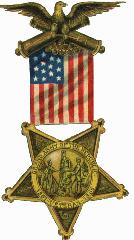This page updated August 19, 2011

In early 1866 the United States of America--now securely one nation again--was waking to the reality of recovery from war, and this had been a much different war. In previous conflicts the care of the veteran warrior was the province of the family or the community. Soldiers then were friends, relatives and neighbors who went off to fight--until the next planting or harvest. It was a community adventure and their fighting unit had a community flavor.
By the end of the Civil War, units had become less homogeneous, men from different communities and even different states were forced together by the exigencies of battle where new friendships and lasting trust was forged. With the advances in the care and movement of the wounded, many who would have surely died in earlier wars returned home to be cared for by a community structure weary from a protracted war and now also faced with the needs of widows and orphans. Veterans needed jobs, including a whole new group of veterans--the colored soldier and his entire, newly freed, family. It was often more than the fragile fabric of communities could bear.
But probably the most profound emotion was emptiness. Men who had lived together, fought together, foraged together and survived, had developed an unique bond that could not be broken. As time went by the memories of the filthy and vile environment of camp life began to be remembered less harshly and eventually fondly. The horror and gore of battle lifted with the smoke and smell of burnt black powder and was replaced with the personal rain of tears for the departed comrades. Friendships forged in battle survived the separation and the warriors missed the warmth of trusting companionship that had asked only total and absolute committment.
With that as background, groups of men began joining together--first for camaraderie and then for political power. Emerging most powerful among the various organizations would be the Grand Army of the Republic (GAR), which by 1890 would number 409,489 veterans of the "War of the Rebelion."
The final Encampment of the Grand Army of the Republic was held in Indianapolis, Indiana in 1949 and the last member, Albert Woolson died in 1956 at the age of 109 years.
I have listed these alphabetically with the township/lodge listed next to them, if it is known.
Spencer Lodge 93 of Grand Army of Republic
Owen
Morgan
Putnam
George R. BABBS--Spencer
John Henry RUSIE-Brown Twp
Jonathan BRANAM--Clay Twp
James CAMPBELL--Spencer
Dr. J. COBLE--Spencer
Wesley COFFEY--Spencer
I. Louis COURIM--Freedom
James H. COURIM--Freedom
Wallace L. DAGGY--Spencer
Edward DURBIN--Freedom
Albert W. DYER--Franklin
Dr. James M. GOSS--Franklin
Richard T. HARDIN--Spencer
George HICKS
John M. KINNEY--Washington twp
Daniel C. KRINER
Hugh M. LIGHT--Franklin twp
Andrew MASSEY--Gosport
George MASSEY--Gosport
C.C. MATSON
William H. McGUIRE--Spencer
Capt. Robert McNAUGHT--Spencer
William S. MEAD
Dr. M. G. MULLINIX--Spencer
Samuel S. SHARP--Franklin twp
John M. STEWART--Spencer
M.C. STEPHENSON--Franklin twp
William J. SUFFAL--Franklin twp
D.L. WEIR--Gosport